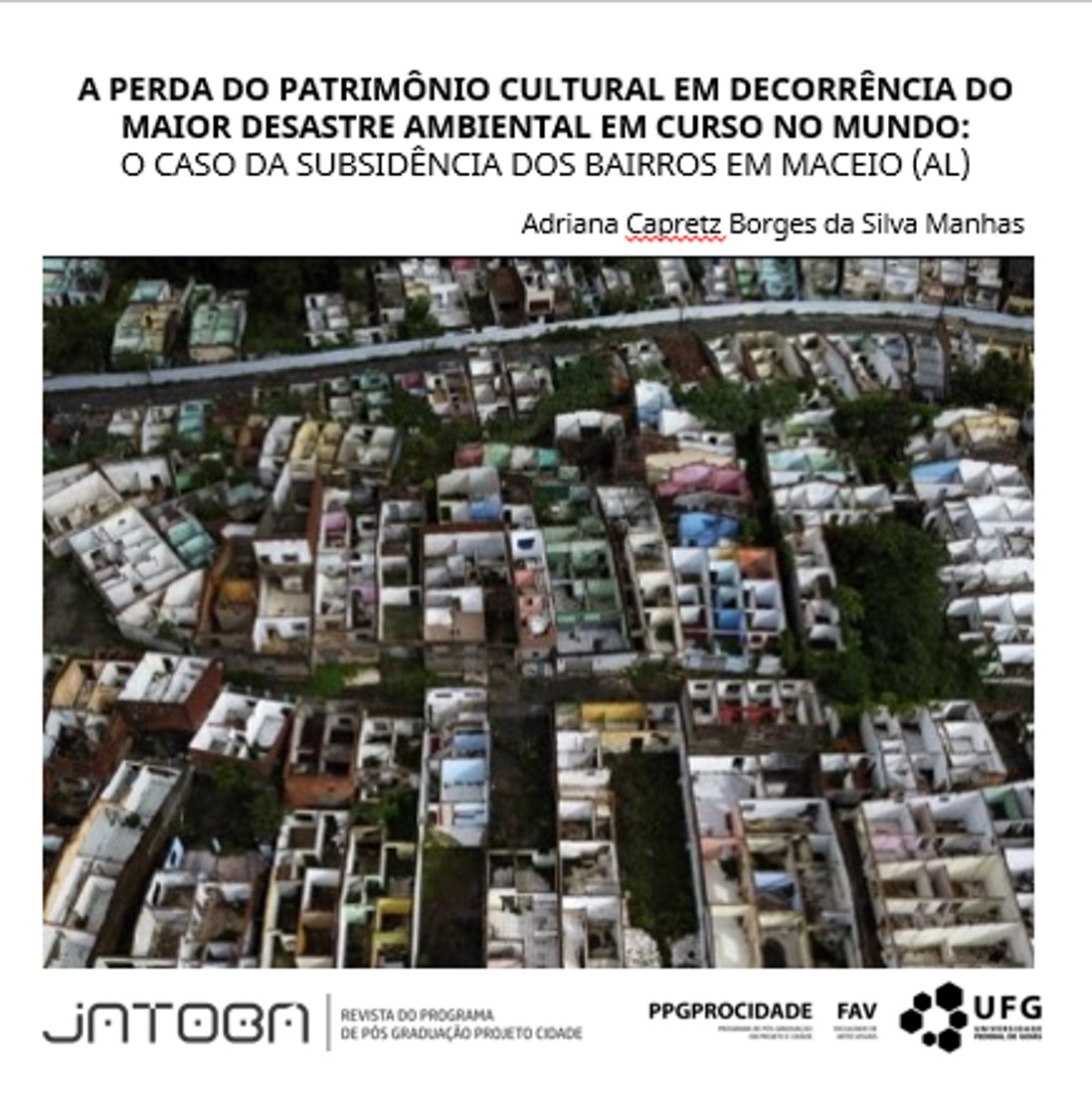The Loss of Cultural Heritage as a Result of the Greatest Ongoing Environmental Disaster in the World
the case of subsidence of neighborhoods in Maceio
DOI:
https://doi.org/10.5216/revjat.v4.73021Keywords:
Subsidence, Maceió, Cultural references, MiningAbstract
One large part of the central area of the municipality of Maceió, the capital of Alagoas, which corresponds to five neighborhoods, was affected by a phenomenon that in geology is called "subsidence", which consists of the abrupt sinking of the surface of the earth's, with little or no horizontal movement, due to the exploitation of rock salt, raw material for the manufacture of plastics, PVC and caustic soda. Due to the imminent risk, the population of four neighborhoods has been removed, leaving more than 15,000 residences in the neighborhoods of Pinheiro, Mutange, Bom Parto and Bebedouro (this last one, a Special Area of Rigid Preservation), beyond the commerces and services that the neighborhoods housed. Three of the now phantom neighborhoods are situated close to Laguna Mundaú and house edifications that reassembled to the beginnings of Maceió's urbanization. In the two neighborhoods which stay in the upper part, Pinheiro and now also part of the Farol, are where the concentration of the few copies of modernist architecture still exists in Maceió. But the loss of cultural references goes beyond the built heritage that can disappear through subsidence or, as it is already been happening, through abandonment. They include the so-called “intangible heritage”, with the weakening of local traditions, popular merrymaking such as quadrilha and coco de roda groups, which existence is exclusively related to the relationship with the territoriality and geographical proximity of the players, since the groups were formed by relatives and neighbors, who were relocated far from each other, making the continuation of traditions unfeasible. This “diaspora” can cause the condemnation of traditions that always were very present in the Alagoas culture, and are also they are the result of resistance from groups descended from enslaved Africans. About the possibility of loss and necessary actions to avoid the disappearance of the material and immaterial patrimony of the affected neighborhoods, we will deal with this article.
Downloads
References
Ações do Ministério Público Federal – AL. Disponível em: <http://www.mpf.mp.br/grandes-casos/caso-pinheiro>. Acesso em: 30 jan 2022.
CARVALHO, Cicéro Péricles de. Formação histórica de Alagoas. 3ª. Ed. Maceió: Edufal, 2015. “A formação da Capital”. 184-198.
MAIA, Álvaro Maia e CABRAL, Paulo. Análise de tensões e dimensionamento de cavernas por dissolução de halita da bacia evaporítica no estado de Alagoas no Brasil. Houston, 1992.
Mapeamento das áreas pelo Serviço Geológico do Brasil – CPRM: Ação Emergencial para o Bairro do Pinheiro em Maceió. Disponível em: <http://www.cprm.gov.br/publique/Gestao-Territorial/Acoes-Especiais/Acao-Emergencial-no-Bairro-Pinheiro-%28Maceio%2C-AL%29-5344.html> Acesso em: 30 jan 2022.
NORA, Pierre. Entre memória e história: a problemática dos lugares. Trad. Yara Aun Khoury.
Revista Projeto História, Revista do Programa de Estudos Pós-Graduados em História daPUC São Pau-lo, n. 10, São Paulo, dez. 1993, p. 7-28.
PLANO DE DESENVOLVIMENTO DE MACEIÓ: DIANÓSTICO E PROGNÓSTICO. Maceió:COMPLAN – Coor-denação Municipal de Planejamento. Vol. 1, 1981
PLEC – Projeto de Levantamento Ecológico Cultural da Região das Lagoas Mundaú e Manguaba. Ma-ceió: SEPLAN/SUDENE/CNRC. Vol. 1. 2. ed, 1980.
PORTAL DE ARQUITETURA ALAGOANA. Site sobre cultura de Alagoas. Disponível : www.arquiteturaalagoana.al.org.br Acesso em: 03 mai 2020.
SANTOS, Jorima Valoz dos. A percepção dos aspectos topofílicos e topofóbicos do bairro Pontal da Barra – Maceió (AL) pelos seus moradores. Dissertação (Mestrado em Dinâmicas do Espaço Habita-do). Programa de Pós-Graduação em Arquitetura e Urbanismo. Universidade Federal de Alagoas, Ma-ceió, 2011
SECRETARIA ESTADUAL DE CULTURA DE ALAGOAS. Disponível em: < http://www.cultura.al.gov.br/> Acesso em 01 abr 2018.
Site da Braskem Alagoas. Disponível em: < https://www.braskem.com.br/alagoas>. Acesso em: 30 jan 2022.
VASSILEVA, Magdalena et. al. A decade-long silente ground subsidence hazard culminating in a me-tropolitan disaster in Maceió, Brazil. Scientific Reports (2021)11:7704. Disponível em: https://doi.org/10.1038/s41598-021-87033-0 . Acesso em: 30 jan 2022.
VIEIRA, Maria do Carmo. “Daqui só saio pó”... Conflitos urbanos e mobilização popular: a Salgema e o Pontal da Barra. Maceió: EDUFAL, 1997.
ZHOURI, Andréa (Org.); R. Oliveira et all. Mineração: violências e resistências: um campo aberto à produção de conhecimento no Brasil. 1.ed.— Marabá, PA : Editorial iGuana; ABA, 2018. 711 kb ; e-PUB.

Downloads
Published
How to Cite
Issue
Section
License
Copyright (c) 2022 Revista Jatobá

This work is licensed under a Creative Commons Attribution 4.0 International License.
- Autores mantém os direitos autorais e concedem à revista o direito de primeira publicação, com o trabalho simultaneamente licenciado sob a Licença Creative Commons Attribution 4.0 que permite o compartilhamento do trabalho com reconhecimento da autoria e publicação inicial nesta revista.
- Autores têm autorização para assumir contratos adicionais separadamente, para distribuição não-exclusiva da versão do trabalho publicada nesta revista (ex.: publicar em repositório institucional ou como capítulo de livro), com reconhecimento de autoria e publicação inicial nesta revista.
- Autores têm permissão para publicar e distribuir seu trabalho online (ex.: em repositórios institucionais ou na sua página pessoal) após a publicação inicial nesta revista, já que isso pode gerar alterações produtivas, bem como aumentar o impacto e a citação do trabalho publicado (Veja O Efeito do Acesso Livre).
- Foram feitos todos os esforços para identificar e creditar os detentores de direitos sobre as imagens publicadas. Se tem direitos sobre alguma destas imagens e não foi corretamente identificado, por favor, entre em contato com a revista Jatobá e publicaremos a correção num dos próximos números.














